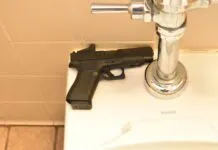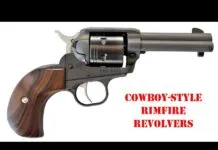
Not many would doubt that the Colt 1911-A1 (or any good clone thereof) has been the premier self-defense handgun of the 20th century, nor is there much doubt of its continuing viability into the 21st. Only problem with the old warhorse, as many concealed carriers can tell you, is that it’s heavy. It pulls your pants down on the side where it’s carried, and makes your belt too tight. A woman who puts it in a purse has a lot of unwelcome weight on her shoulder. Further, the .45 1911 is not exactly tiny. Because of its weight and bulk, the grand old dame of self-defense pistols often gets left at home.
Many shooters who own the 1911 also own smaller and lighter guns for concealed carry. However, the ban on magazine capacity over ten rounds led manufacturers to replace great numbers of relatively small rounds (9mm) with fewer rounds of great power (.45 ACP). The result is that concealed carriers, or any shooters who want small guns with lots of power, have a new generation of .45 autos to choose from that are lighter and smaller than the old full-size 1911.
Some of the new guns are essentially shrunken clones of the 1911, with identical takedown mechanisms and with all the controls exactly like those on the bigger gun. A few of these have innovations that make takedown a bit different, and of course there are some entirely new designs, having only the cartridge in common with the small/light 1911 clones.
We decided to find out if a smaller 1911-type means a better gun, or just malfunctions, more recoil, and excess noise for the shooter. We chose small versions of the same full-size .45 ACP 1911 types we tested in the June 1999 issue of Gun Tests. They are the Colt Concealed Carry Officer (CCO), $813; the Springfield LW Champion, $629; the Kimber Compact Custom, $677; and the Glock Model 30, $668. The first three hold seven rounds in their magazines, and the Glock holds ten.
Colt’s Concealed Carry Officer (CCO)
Our recommendation: We feel the CCO Colt has so much to offer the concealed carry owner that we’d place it a very close second to the Kimber, despite it needing work, including fixing the trigger and filing off sharp edges. In fact, nothing short of a very expensive custom handgun has the features, looks and handling of the CCO. Buy it.
The CCO is a combination of two of Colt’s guns, and it uses the best parts of each. It is the Commander slide (stainless) paired with the lightweight (aluminum alloy) Officer’s Model frame. The result has the same appearance as the full-size 1911, but with all dimensions shrunken. At 25.6 ounces it weighs 12 ounces less than the all-steel 1911. The biggest difference here is that this gun can be carried all day long without the wearer feeling its weight or bulk.
The gun came with rubber grips with finger grooves, a plastic mainspring housing, and a pull weight of over 6 pounds. The Colt CCO had sharp edges along the sides of the top rib and around the edges of the ejection port that needed attention. We hasten to add that the Springfield Champion needed some serious file work too. It had edges that can easily cut you, much less your $75 holster. However, the rear sight was of a shape that would be easy on the hand while clearing stovepipe jams, and it also provided the longest possible sight radius.
The Colt CCO came with a skeletonized Commander-style hammer, beavertail safety, slightly opened magazine well, extended thumb safety, and a perfect sight picture. It also had an undercut trigger guard that added greatly to the solid feel of this handgun. It came with two magazines in a well-made plastic case.
The CCO had exactly the same disassembly procedure as the full-size 1911. There were no tricks or surprises here. On the range, the CCO gave acceptable accuracy, though we’d have liked it to be better. We found—once again—that .45 automatic pistols have distinct preferences for ammunition. So-called hardball from different makers gave distinctly different results on the target. The CCO preferred the Winchester 230-grain FMJ over the 230-grain PMC and the 200-grain JHP Blazer.
One thing our test results don’t show is that the CCO was the quickest to get on target. Presenting the gun from the ready position, the CCO was the fastest to bring to bear on any given target, mostly because of its superb balance and light weight. It was also fastest on multiple targets for the same reasons. Its light weight hindered the speed of follow-up shots just a bit over the Kimber, but the CCO’s sight radius advantage tended to make up the difference. On the downside, the Kimber and Champion had shorter slides that were a bit easier to get out of the holster.
Springfield Champion
Our recommendation: We didn’t like the really poor accuracy, takedown method, or the sharp edges of the $629 Champion, but we loved its trigger pull, looks, and overall feel. You’d need to do some serious filing on the front of the slide to protect your holster, and if you’re at all serious about your shooting, you’ll have to improve its accuracy.
The Champion, like the CCO and Kimber, came with essentially all the goodies any serious handgunner would want. These include a long Videki trigger, beavertail with a bump, skeleton Commander-style hammer, extended thumb safety, Novak rear sight, flared ejection port, opened magazine well, flat black finish and checkered wood grip panels. The front sight was not dovetailed into the slide, as it was on the CCO and Kimber. The sight picture was, like that of the CCO and Kimber, perfect. The trigger pull, like that of last month’s test-winning Springfield, was crisp and reasonably light, breaking at 4.0 pounds, and entirely free of creep. Our hat is off to Springfield’s staffers for putting consistently good triggers in all their handguns we’ve encountered. The Champion came with two magazines and cleaning brush in a nicely fitted case.
This gun closely resembled the Colt Lightweight Commander, though the slide of the Champion is not as long as the Commander (or CCO) slide. The grip frame is the same depth as the full-size 1911, which means the shooter’s hand has a bigger handle to grasp. For those with large hands this gun will appeal more than either the Kimber or the Colt CCO. Does that larger grip mean this gun is harder to conceal? Yes, to some extent, but it really depends on the anatomy of the carrier. The grip is a full half-inch longer. However, if you (men) carry the gun just behind the hip bone, the grip protrudes along your back, and the extra length may not be noticeable. You’ll have to try it and see. We suspect most women will find the grip longer than necessary.
We found we could make extremely fast reloads a bit easier and more positively with the full-depth frame of the Champion because the little finger of our strong hand didn’t get in the way. With the CCO or Kimber we had to lift the little finger of the strong (right) hand, and be sure to hold the reloading (left) hand perfectly straight to make sure the magazine seated fully.
The front of the slide on the Champion was too sharp. It was as though it had been honed to gouge things. The ejection port also had sharp edges, all of which would need to be removed.
Our shooting produced lots of vertical stringing in all groups, and the Champion’s accuracy was poorest of all four guns in this test. It had a feeding problem when one round of the short 200-grain Blazer JHP hung up on the feed ramp. That ammunition is much shorter than any other JHP ammo we’ve seen, and the aluminum cases are not as slick as brass. We’d never use that particular ammo for any serious purpose, but still, the gun should have fed it perfectly. One of our personal 1911 handguns feeds empty cases perfectly.
We couldn’t figure out how to get the Springfield apart for cleaning. We learned from the instruction manual that disassembly is actually quite simple. Working against the recoil spring’s pressure, you align the small notch in the side of the slide and push out the slide stop, then wrap your fingers around the slide to contain the recoil spring, then take the slide off forward. Getting the whole thing back together takes a bit of skill, and we suspect the novice will have some trouble with this system. Also, we really don’t like the open holes in the front of this gun that can let in dirt or water.
The Springfield’s feed ramp is integral with the barrel. Some shooters have found that with extensive shooting of hollowpoint ammunition, the bullet nose can make permanent gouges in aluminum-alloy feed ramps, as on the Colt CCO. Hence the invention of the integral all-steel ramp. However, we have seen CCOs that have been fired with many rounds of JHP ammo and had no visible wear on their aluminum-alloy ramps. We conclude that if this is a problem with aluminum-frame guns, it would take many more rounds than we fired to prove it.
Kimber Compact Custom
Our recommendation: At a cost of $677 the Kimber offered the most value of all guns in this test. It shot extremely well, had perfect reliability, looked great, and didn’t need anything at all done to it. The trigger pull did have some creep, but we could live with it. The folks at Kimber know how to put together a fighting .45. This one’s a clear-cut winner.
Our test gun had a steel frame the same height as that on the CCO Colt, and a slide the same length as the Springfield Champion. The Kimber and Springfield slides were a quarter-inch shorter than that of the CCO. The Kimber came in a decent case with only one magazine. It had a very slight amount of creep in an otherwise excellent pull of 4.4 pounds. The Kimber had checkered wood grip panels, their standard plastic “designer” trigger, plastic mainspring housing, beavertail grip safety, extended thumb safety, opened magazine well, outstanding sights that included a dovetailed front blade and, wonder of wonders, no sharp edges on the front of the slide or on the ejection port.
We have no idea why the Colt and Springfield, and many other guns, for that matter, are made with edges that would destroy an expensive leather holster in very short order. We assume those in charge of design have never put one of their handguns into a holster. We tried getting the Springfield into a fine Milt Sparks “Bruce Nelson Summer Special” holster, and it would not go. The slide cut into the leather. If we had forced it we would have destroyed the holster. There is no excuse for this, and these sharp edges make us downgrade otherwise excellent handguns.
Takedown of the Kimber is tricky, but intuitive. Remove the magazine and lock the slide in the fully rearward position. Then insert a pin, easily made from a paper clip, into a hole in the recoil spring pin, under the barrel, and release the slide gently forward. This removes all spring tension and the slide lock pin may be easily removed and the slide taken off the frame. The recoil spring and pin, locked together with your homemade pin, may then be drawn out of the slide and then the barrel comes out the front, and that’s as much disassembly as is usually needed. Reassembly is very easy.
The Kimber’s accuracy was about as good as the Glock’s, actually slightly better with Winchester 230-grain ball. However, whoever buys this one will have to file on the front sight to get the gun to center its shots. All loads shot about 2 inches low at 15 yards. We had no malfunctions with this fine little pistol.
The only problem with the Kimber is that it is heavier than the Colt CCO, hence, it’s harder to carry all day. However, the Kimber is available with a lightweight frame if you want it. (Kimber also offers this gun with a full-size grip, and of course Springfield and Colt’s also offer a variety of different models. Springfield and Kimber have websites well worth a visit.)
Glock Model 30
Our recommendation: With a list price of $668 the Glock should be a viable contender for your small-.45 attention. Our test gun needs more light between front blade and rear notch, and we’d like it to be slimmer, but it worked perfectly and shot extremely well. Give it a long, hard look if you want compact power.
One of the more pleasant aspects of this fine 11-shot handgun was that although the gun was notably lighter than any of the other three test handguns, the recoil was such that both hands stayed on the gun. With the other three 1911-types, our supporting hand more or less came unglued, even with the hardest possible Weaver grip. One of our test shooters complained that the trigger pinched his finger no matter what he tried to overcome it. However, even he admired the great accuracy and reliability of the Glock. One of our testers pinched his hand while inserting the magazine before he learned the knack. One problem we had is that the slide lock was either bent or of the wrong shape because it was hard to operate.
We had one other complaint, common to all Glocks we’ve seen. The front sight is too wide for the rear sight notch. There isn’t enough daylight between the two for the fastest sight pickup. If Glock could put a trigger pull of, say, five pounds maximum on this gun and have a cleaner, less spongy break, we think they’d sell lots more guns. That is all that’s keeping one of our test shooters from buying his own. This one had a pull weight of right at 7 pounds, and it is spongy in feel. In case you didn’t know, there is no safety lever on the Glock. The trigger is its own safety, and the gun can’t fire unless the little protrusion on the trigger is first depressed.
With the mag in place the shooter can get a solid, full-hand grasp on the gun. The magazine bottom is thick enough to provide room for the third finger. Without it, only two fingers hold the gun. By the way, none of the guns had a magazine safety, which we applaud.
This Glock had its square slide noticeably thinned at the front, which made for much easier holstering. The slide was still just as wide and blocky as the full-size Model 21 we tested last month, but the Model 30 was 1.3 inches shorter and almost 3 ounces lighter. We think a slimmer profile will also help Glock sell more guns. Glock now has such a .45, called the Model 36, that uses a single-stack magazine. We very much look forward to trying it.
Gun Tests Recommends
For cost, performance, and overall quality the Kimber Compact Custom, $677, would be our first choice of these test guns as they came from the factories. It offers the most bang for the buck, didn’t really need anything done to it, and looked great and shot great to boot. What more could you ask? Buy it.
At $813 the Colt’s Concealed Carry Officer (CCO) is not inexpensive, and it needs attention to make it right. However, its balance, light weight, outstanding handling qualities and great looks, combined with complete reliability, make it well worth spending a bit of extra money on.
We couldn’t fault the Glock 30, $668, for accuracy or for function. It worked every time and beat all but the Kimber badly for accuracy. We know we would be able to shoot it better if it had a better trigger pull. We’ll say it again, we’re liking Glocks more and more. Be sure to look at the Glock if you need a reliable and compact .45. If you can live with its trigger, buy it.
The Springfield LW Champion, $629, felt and looked great, but we thought it ought to have shot better than it did. Also, we didn’t like the razor-sharp edges or the takedown method. We really liked the full-size grip of this handgun, and if we could get its troubles repaired inexpensively it would be worth considering.




























